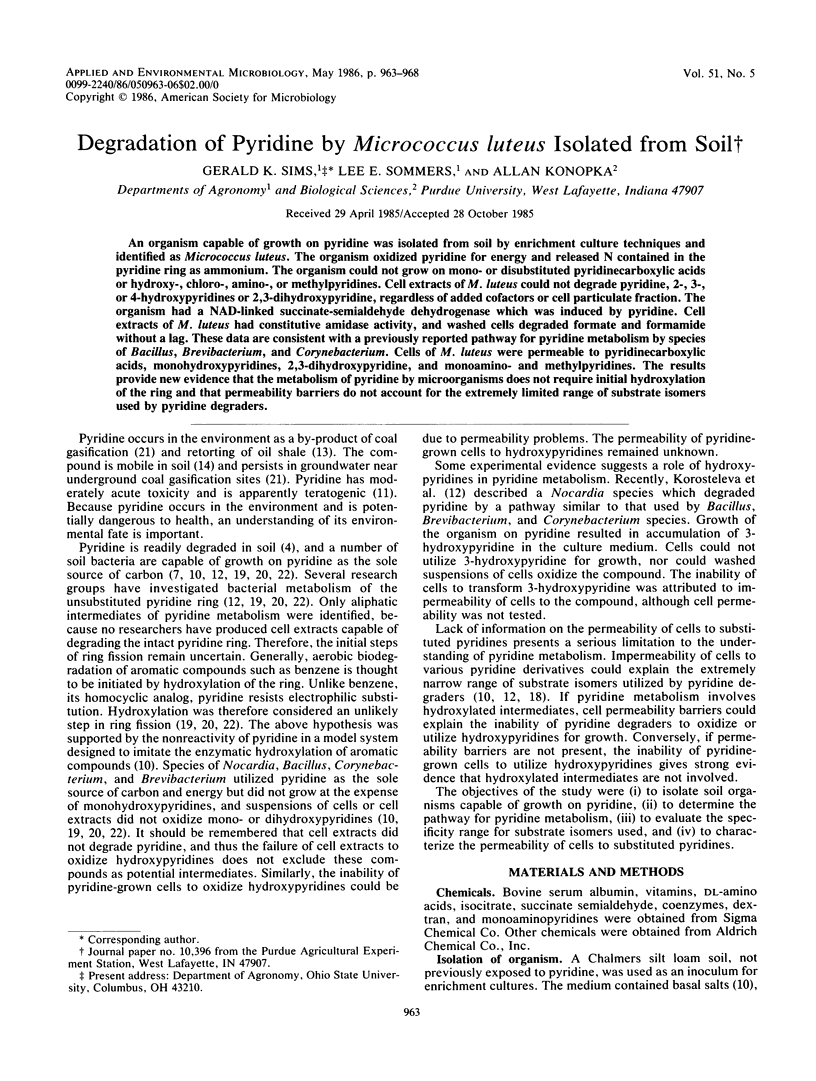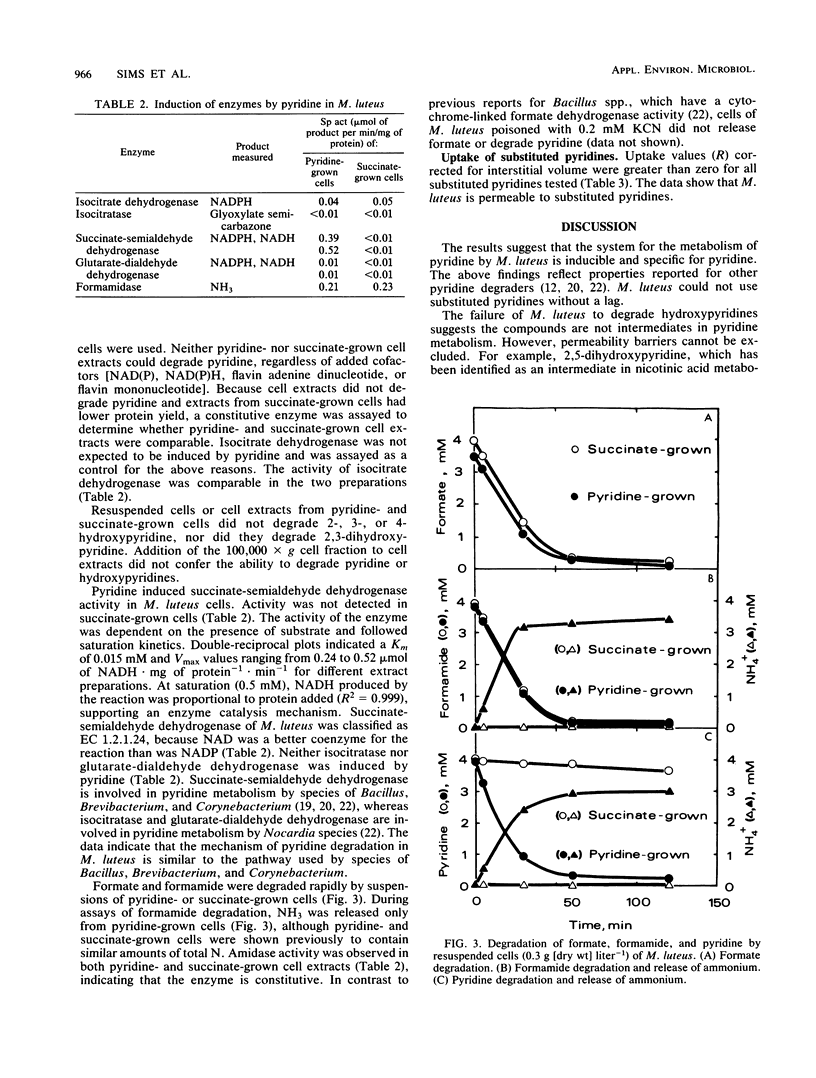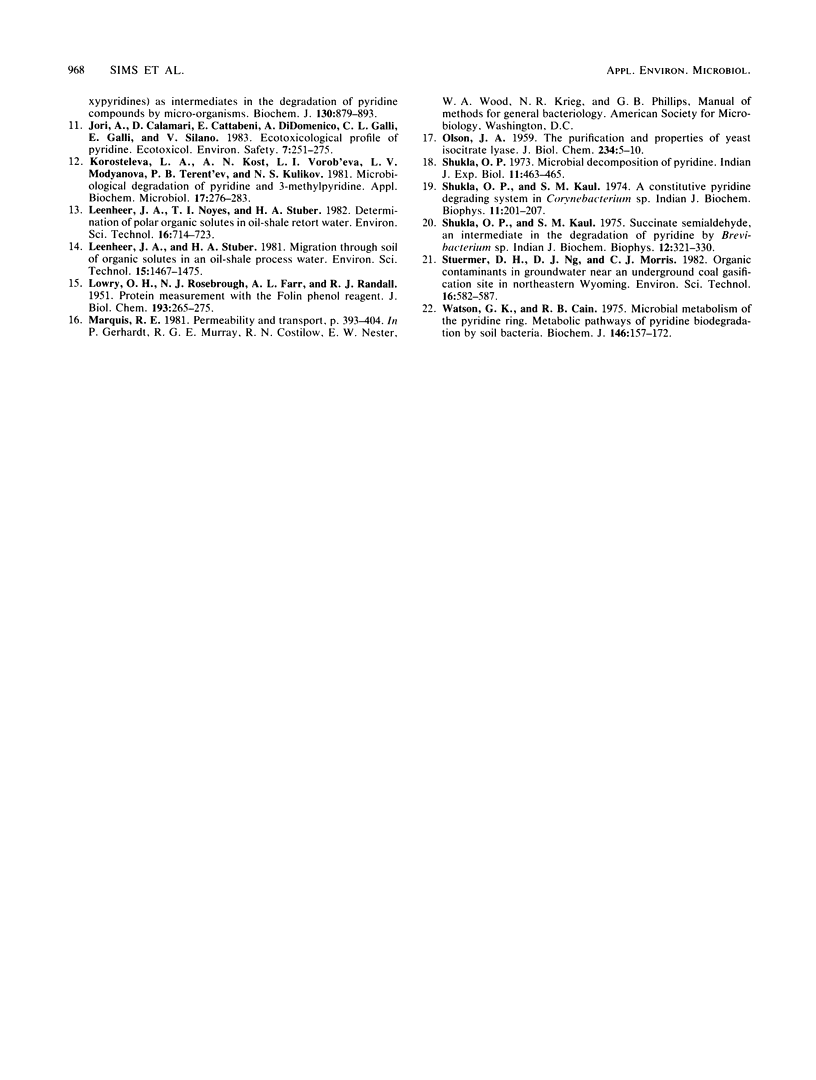Abstract
An organism capable of growth on pyridine was isolated from soil by enrichment culture techniques and identified as Micrococcus luteus. The organism oxidized pyridine for energy and released N contained in the pyridine ring as ammonium. The organism could not grow on mono- or disubstituted pyridinecarboxylic acids or hydroxy-, chloro-, amino-, or methylpyridines. Cell extracts of M. luteus could not degrade pyridine, 2-, 3-, or 4-hydroxypyridines or 2,3-dihydroxypyridine, regardless of added cofactors or cell particulate fraction. The organism had a NAD-linked succinate-semialdehyde dehydrogenase which was induced by pyridine. Cell extracts of M. luteus had constitutive amidase activity, and washed cells degraded formate and formamide without a lag. These data are consistent with a previously reported pathway for pyridine metabolism by species of Bacillus, Brevibacterium, and Corynebacterium. Cells of M. luteus were permeable to pyridinecarboxylic acids, monohydroxypyridines, 2,3-dihydroxypyridine, and monoamino- and methylpyridines. The results provide new evidence that the metabolism of pyridine by microorganisms does not require initial hydroxylation of the ring and that permeability barriers do not account for the extremely limited range of substrate isomers used by pyridine degraders.
Full text
PDF





Selected References
These references are in PubMed. This may not be the complete list of references from this article.
- CONWAY E. J., DOWNEY M. An outer metabolic region of the yeast cell. Biochem J. 1950 Sep;47(3):347–355. doi: 10.1042/bj0470347. [DOI] [PMC free article] [PubMed] [Google Scholar]
- ENSIGN J. C., RITTENBERG S. C. A CRYSTALLINE PIGMENT PRODUCED FROM 2-HYDROXYPYRIDINE BY ARTHROBACTER CRYSTALLOPOIETES N.SP. Arch Mikrobiol. 1963 Dec 10;47:137–153. doi: 10.1007/BF00422519. [DOI] [PubMed] [Google Scholar]
- ENSIGN J. C., RITTENBERG S. C. THE PATHWAY OF NICOTINIC ACID OXIDATION BY A BACILLUS SPECIES. J Biol Chem. 1964 Jul;239:2285–2291. [PubMed] [Google Scholar]
- Jori A., Calamari D., Cattabeni F., Di Domenico A., Galli C. L., Galli E., Silano V. Ecotoxicological profile of pyridine. Working party on ecotoxicological profiles of chemicals. Ecotoxicol Environ Saf. 1983 Jun;7(3):251–275. doi: 10.1016/0147-6513(83)90071-4. [DOI] [PubMed] [Google Scholar]
- LOWRY O. H., ROSEBROUGH N. J., FARR A. L., RANDALL R. J. Protein measurement with the Folin phenol reagent. J Biol Chem. 1951 Nov;193(1):265–275. [PubMed] [Google Scholar]
- OLSON J. A. The purification and properties of yeast isocitric lyase. J Biol Chem. 1959 Jan;234(1):5–10. [PubMed] [Google Scholar]
- Shukla O. P., Kaul S. M. A constitutive pyridine degrading system in Corynebacterium sp. Indian J Biochem Biophys. 1974 Sep;11(3):201–207. [PubMed] [Google Scholar]
- Shukla O. P. Microbial decomposition of pyridine. Indian J Exp Biol. 1973 Sep;11(5):463–465. [PubMed] [Google Scholar]
- Watson G. K., Cain R. B. Microbial metabolism of the pyridine ring. Metabolic pathways of pyridine biodegradation by soil bacteria. Biochem J. 1975 Jan;146(1):157–172. doi: 10.1042/bj1460157. [DOI] [PMC free article] [PubMed] [Google Scholar]


